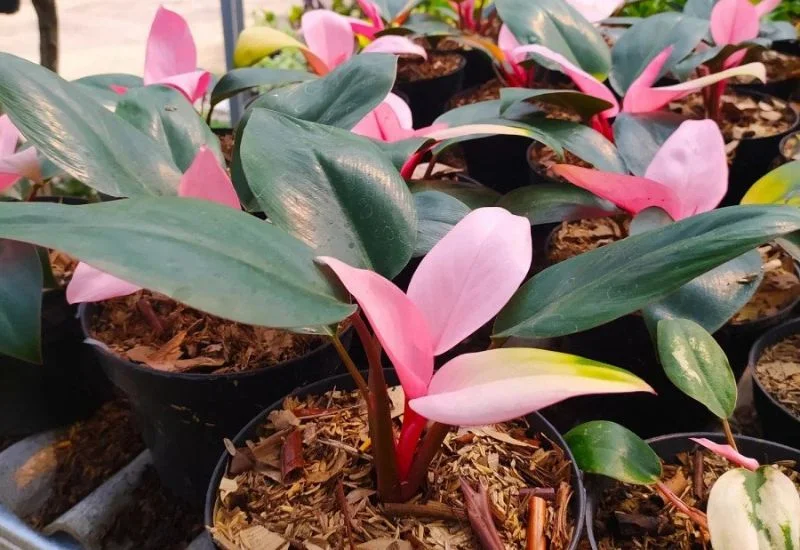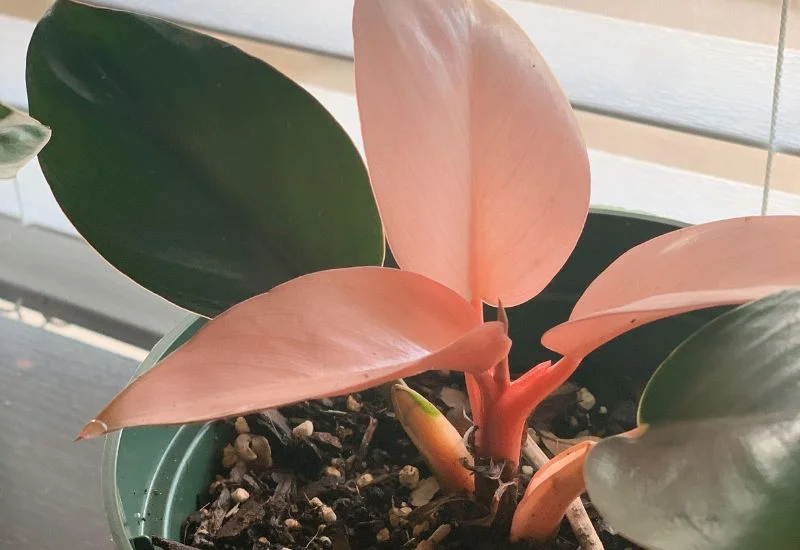In this blog post, you’re going to learn how to easily propagate and care for Philodendron Pink Congo.
This is a comprehensive guide covering reliable information about different aspects of this cultivated variety.
In this post, I’ll cover:
- Interesting Facts
- Propagation
- Repotting
- Care
- Similar Plants
- Solutions to Common Problems
So, if you are looking to propagate and care for Philodendron Pink Congo, this guide is for you.
Let’s jump right in!
Fun Facts
| Common Name | Philodendron Congo |
| Botanical Name | Philodendron erubescens |
| Family | Araceae |
| Plant Type | Perennial |
| Fruit | No |
| Mature Size | 3 feet tall |
| Sun Exposure | Indirect bright sunlight |
| Soil Type | Well-drained, moist soil |
| Soil pH | 5 to 6 |
| Native Area | Central South America and the Caribbean |
| Toxic | Yes |
| Growth | Moderate |
The beautiful appearance of the plant makes it a perfect addition to any household. The plant is perennial and can grow up to 3 feet tall. The plant is low-maintenance and perfect for people who have a busy working routine.
The philodendron pink congo is a native of central South America and the Caribbean. The plant has a moderate growth pattern and compact growth that makes it perfect for your indoor space.
The plant is mainly focused on its beautiful leaves rather than flowers. The flower blooms under the right conditions, which is very hard while keeping it in-house.
The leaves of the plant come in an oval-round shape. The plant’s leaves are dark green with pink variegation.
Benefits

Here is the list of benefits for growing philodendron rojo congo:
Aesthetic Appeal
The beautiful variety of plants not only increases the aesthetic of your home but can also become the center of attention wherever you place it.
Air Purification
The plant naturally works as an air purifier by absorbing harmful chemicals from the air and making the environment clean.
Low Maintenance
The plant is low-maintenance and the best choice for experienced gardeners and novices. The plant does not require water on a daily basis. Just water it once a week and place it in indirect bright sunlight.
Humidity Tolerance
The plant has a high humidity tolerance. You can place the plant near the kitchen, bathroom, or laundry where the humidity level is high.
Growth Habit
The plant grows more in length rather than in width, which makes it the best option for indoor space.
Emotional Wellbeing
The presence of the plant in your home can reduce stress, enhance your mood, and increase your productivity level.
Propagation
The propagation of philodendron pink congo can be done through stem cutting. For cutting select a healthy stem that does not have any discoloration.
The stem should have 3 to 4 leaves. Use only sterilized equipment for cutting. Remove the leaves from the bottom of the stem. Leave the cutting for 12 to 24 hours and let the callous come over the cutting.
Now place the stem into the water and keep it in a warm and humid area. Do not place the cutting in direct sunlight; it might not survive. Change the water at the needed times to prevent bacterial infection.
In 2 to 3 weeks, the new roots will start coming out. Once the roots are 1 inch long, you can place your cutting into the pot filled with well-drained soil.
Repotting
The plant needs repotting every 1 to 2 years. The signs can be an outgrowth of roots from the drainage hole, less availability of soil, and roots becoming more circled. Bring more pots 3 to 4 inches bigger than the previous one.
Care

Here are the steps you need to keep in consideration while taking care of your philodendron rojo congo:
Pruning
The plant does not require pruning often. You can prune it when you see dead leaves or to manage the growth and size of the plant.
Soil
This plant prefers well-drained, moist soil. The soil should be rich in organic nutrients. Consider adding ingredients such as perlite and orchid bark to the soil; this would be great.
Pot
Ceramic or terracotta pots are recommended. The pots can retain the necessary moisture for the plant and allow space for air circulation. These pots also can absorb extra moisture from the soil.
Water
The plant needs water when the top inch of the soil starts to get dry. You can check the soil with the help of your hands.
This plant usually needs water once a week in summer and spring and in winter and fall the plant needs water every two weeks. Avoid overwatering as it can cause root rot.
Light
Light is very crucial for the philodendron pink congo. Place the plant in the bright, indirect sunlight. The direct light can scorch the leaves of the plant. If you do not have the perfect place to light, you can buy plant growth lights.
Fertilizer
For fast and healthy growth, plants need fertilizer once a month. Use well-balanced and liquid-based fertilizer.
Avoid applying fertilizer to dry soil as it can burn the plant roots. Before applying fertilizer, water your plant first. Do not use fertilizer in winter and fall.
Placement
The plant needs bright, indirect light. Place it near the east-facing window. If you do not have a good spot of indirect light, you can draw sheer curtains to protect it from direct sunlight. Exposure to direct sunlight can burn the leaves.
Temperature and humidity
The philodendron pink congo prefers a warm and humid environment to thrive. The preferred temperature for this plant is 65 °F to 79 °F.
A temperature below 60 can make the plant saggy and reduce its vibrancy. The plant can do well at normal household humidity levels.
If your house environment is too dry you can increase the humidity around the plant. You can place a humidifier or tray filled with pebbles and water.
Common Problems

Here is the list of common problems that every plant faces:
Pests
The most common plant pests are mealybugs, aphids, scales, spider mites, and fungal ants. These pests start consuming your plant. To prevent them, you need to inspect your plant.
If you find any bugs, wipe them off with a damp cloth. You can apply neem oil to naturally prevent them or use a solution spray that will kill the bugs.
Fungal Diseases
Fungal infection is the most common disease in philodendron rojo congo. It causes root and rust spots. The reasons for this can be overwatering and poor drainage systems.
The unnecessary stay of water leads to root rot. Avoid overwatering and make sure the drainage hole of the pot is working properly.
Brown Tips
The brown tips of the plant can be because of low humidity. To stop the damage, place your plant in a more humid area. You can increase the humidity around the plant by placing a humidifier.
Curling Leaves
There can be several reasons for curling leaves. The more use of fertilizer, the more sun exposure and overwatering.
Before dealing with the problem inspect the plant environment to find out the main reason and act accordingly.
Yellow leaves
Yellow leaves are common in the plant, but when the young leaves start to turn yellow it means something is wrong in the environment.
The reason can be overwatering, underwatering, and more exploration of light. Try to find out which factor is affecting your plant to treat the problem.
Varieties & Similar Plants
The plant does not have varieties, but here is a list of similar plants of philodendron pink congo:
Similar plants
- Philodendron Pink Princess
- Philodendron ‘Rojo Congo’
- Philodendron ‘Imperial Red’
Ready to Grab a Philodendron Pink Congo to add beauty to your home garden?
All the above information is reliable, and you’ll see outstanding results if you want to grow or care for this plant.
